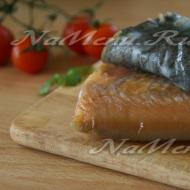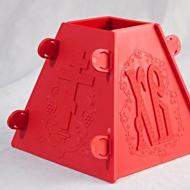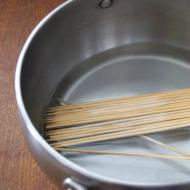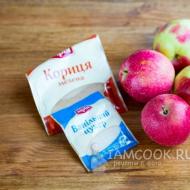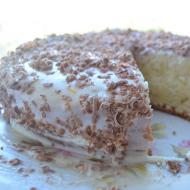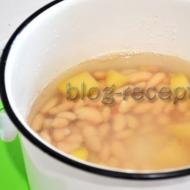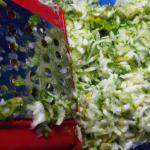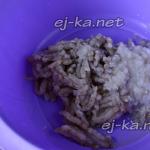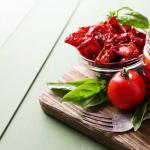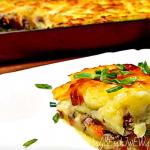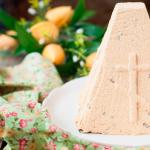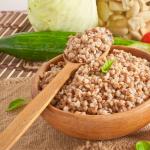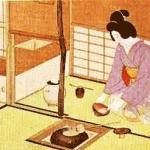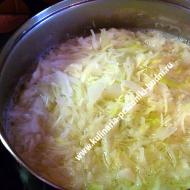
Preparing sugar syrup using the hot method. Preparation of sugar syrup in the production of soft drinks. Sugar syrup ball
The invention relates to sugar production. The method of preparing sugar syrup involves dissolving crystalline sugar when heated, filtering and decolorizing the syrup. Sugar dissolution is carried out at 75 - 95 o C until the dry matter content is 70 - 75%. In this case, after decolorization, an anti-crystallizer is introduced into the syrup in an amount of 2 - 5% by weight of the syrup, which is used as low-sugar starch syrup with a content of reducing substances of 15 - 38%. The method ensures an increase in the concentration of sugar in the syrup and an increase in its shelf life. 1 table
The invention relates to sugar production technology and is intended to increase the concentration of sugar in syrup and increase the shelf life of sugar syrup. The closest to the invention is a method for preparing sugar syrup, which involves dissolving crystalline sugar when heated, filtering and decolorizing the syrup [Instructions for conducting the technological process of refined sugar production. -Kiev, VNIISP, 1984, - 310 pp.] The disadvantage of this method is that the concentration of syrup does not exceed the value corresponding to the concentration of a pure saturated sugar solution. At such low sugar concentrations, long-term storage of syrup is impossible due to the possible development of microorganisms. The technical result of the invention is to increase the concentration of sugar in the syrup and increase the shelf life of the sugar syrup. This result is achieved by the fact that the proposed method for preparing sugar syrup involves dissolving crystalline sugar when heated, filtering and decolorizing the syrup. Sugar dissolution is carried out at a temperature of 75-95 o C until the dry matter content is 70-75%. In this case, after decolorization, an anti-crystallizer is introduced into the syrup in an amount of 2-5% by weight of the syrup, which is used as low-sugar starch syrup with a content of reducing substances of 15-38%. The method is carried out as follows. Crystalline granulated sugar is dissolved in water at a temperature of 75-95 o C. At such a high temperature, partial sterilization of the solution occurs. Most microorganisms that enter the clearing apparatus with crystalline sugar or water die. Substances of colloidal degree of dispersion, which may be present in granulated sugar due to insufficient degree of its purification or as a result of the activity of microorganisms, coagulate at high temperatures. Dissolution of granulated sugar occurs until the concentration of dry substances is 70-75%. Sugar syrups with a high content of dry substances are an unfavorable environment for the development of microorganisms that, as a result of their vital activity, consume sucrose. For the most part, the pH value of the syrup in the presence of microorganisms decreases and the reaction of the medium becomes acidic. At pH< 7-8 растворы сахарозы менее устойчивы, то есть происходит частичный гидролиз сахарозы. Значение pH сиропа при растворении кристаллического сахара в клеровочном аппарате поддерживают 6,8-7,2. При таком значении pH сахароза в растворителе практически не разрушается. Полученный сахарный сироп подвергают фильтрации для удаления механических примесей и обесцвечиванию с помощью адсорбента. Освобожденный от примесей сироп более устойчив при хранении. В фильтрованный и обесцвеченный сироп вводят низкоосахаренную крахмальную патоку с содержанием редуцирующих веществ 15-38%. Содержащиеся в патоке продукты гидролиза крахмала, такие как олигосахариды и декстрины, являются по отношению к сахарозе антикристаллизаторами, что позволяет повысить концентрацию сахарозы в растворе до 70-75%. Такие концентрированные сахарные растворы в присутствии низкоосахаренной крахмальной патоки остаются ненасыщенными, то есть при хранении сиропа выпадения кристаллов из раствора не возникает. Низкоосахаренную крахмальную патоку добавляют в количестве 2-5% к массе сиропа. При большем содержании патоки возрастает содержание несахаров в сиропе, при меньшем содержании снижается антикристаллизационный эффект. Содержание редуцирующих веществ в низкоосахаренной крахмальной патоке 15-38%. При меньшей степени гидролиза крахмала получаются декстрины с высокой степенью полимеризации, которые не обладают высокими антикристаллизационными свойствами и степенью сладости. При большой степени гидролиза крахмала получаются олигосахариды с низкой степенью полимеризации и инвертный сахар - смесь глюкозы и фруктозы, которые не обладают антикристаллизационными свойствами. Пример 1. Берут 700 г кристаллического сахара, добавляют 300 мл воды, нагревают до 75 o C, фильтруют, добавляют 10 г активного угля при перемешивании, смесь фильтруют, добавляют 20 г низкоосахаренной крахмальной патоки с содержанием CB=78% и PB=38%, тщательно перемешивают в течение 15 минут и охлаждают до 20 o C. Получают 1020 г сиропа с CB=70,2%, CX=68,66%, Ч=97,82%, pH 6,9, число микроорганизмов (мезофилов и термофилов) в пересчете на 10 г сахара - 2600. Сироп выдерживают при 20 o C в течение 72 ч и анализируют: СВ=70,2%, СХ= 68,66%, Ч= 97,82%, pH 6,9, число микроорганизмов (мезофилов и термофилов) в пересчете на 10 г сахара 2920; кристаллы в растворе не обнаружены. Пример 2. Берут 700 г кристаллического сахара, добавляют 300 мл воды, нагревают до 95 o C, фильтруют, добавляют 10 г активного угля при перемешивании, смесь фильтруют, добавляют 50 г низкоосахаренной крахмальной патоки с содержанием СВ=78% и РВ=15%, тщательно перемешивают в течение 15 минут и охлаждают до 20 o C. Получают 1050 г сиропа с СВ=70,38%, СХ=66,66%, Ч=94,72%, pH 6,8, число микроорганизмов (мезофилов и термофилов) в пересчете на 10 г сахара 2590. Сироп выдерживают при 20 o C в течение 72 ч и анализируют: СВ=70,38%, СХ= 66,66%, Ч= 94,72%, pH 6,8, число микроорганизмов (мезофилов и термофилов) в пересчете на 10 г сахара 2870; кристаллы в растворе не обнаружены. Пример 3 (известный способ). Берут 635 г кристаллического сахара, добавляют 365 мл воды, нагревают до 75 o C, фильтруют, добавляют 10 г активного угля при перемешивании, смесь фильтруют и охлаждают до 20 o C. Получают 1000 г сиропа с СВ= 63,50%, СХ= 63,37%, Ч=99,80%, pH 6,9, число микроорганизмов (мезофилов и термофилов) в пересчете на 10 г сахара 2580. Сироп выдерживают при 20 o C в течение 72 ч и анализирую: СВ=63,50%, СХ= 63,14%, Ч= 99,43%, pH 6,4, число микроорганизмов (мезофилов и термофилов) в пересчете на 10 г сахара 4790; кристаллы в растворе не обнаружены. Результаты анализа сиропов представлены в таблице. Из данных таблицы следует, что нагревание до высокой температуры и введение низкоосахаренной крахмальной патоки в сироп позволяет повысить концентрацию сахара на 5-10% и увеличить срок хранения сиропа без изменения качественных характеристик.
Claim
A method of preparing sugar syrup, including dissolving crystalline sugar when heated, filtering and decolorizing the syrup, characterized in that the dissolution of sugar is carried out at 75 - 95 o C until the dry matter content is 70 - 75%, while an anti-crystallizer is introduced into the syrup after decolorization in the amount of 2 - 5% by weight of syrup, which is used as low-sugar starch syrup with a content of reducing substances of 15 - 38%.
Sugar syrup is a semi-finished product used to prepare blends of drinks, commercial syrups and kvass. White sugar syrup is a concentrated aqueous solution of sugar. Sugar is diluted in water (in a ratio of 1:1.1), brought to a boil, skimmed off, and boiled for 1-2 minutes. And cool to 20 degrees. Then add cognac or dessert wine, rum. Used for impregnation of biscuit PF, rum baba, etc. The temperature of the syrup during impregnation should not be higher than 20 degrees. The finished sugar syrup should contain 60-65 g of dry substances per 100 g of syrup. Invert sugar syrup should not contain more than 55% invert sugar. The syrup must be colorless and transparent and free from foreign odor and taste, suspensions and inclusions.
Shelf life 35 hours
Making lipstick. Use in the manufacture of confectionery products. Quality requirements.
Sugar is dissolved in water, brought to a boil, and the resulting foam is carefully removed. After this, the cauldron is covered and boiled at high boiling, then molasses heated to 50 degrees is added so that the syrup does not become sugary. Molasses can be replaced with inert syrups or food acids; food acids are added at the end of cooking. After adding molasses, boil the lipstick to 115-117 degrees. The prepared fondant syrup is quickly cooled. After cooling, beat the syrup. The finished lipstick is left to mature for 12 hours. Lipstick can be tinted with dyes. Fondant is used to decorate confectionery products.
Viscous, delicate, plastic, dense, glossy consistency. Stored for 35 days
Preparing buttercream with condensed milk and milk syrup (“new”). Use in the manufacture of confectionery products. Quality requirements. Storage conditions and terms of sale.
Mental basic cream with condensed milk: Cut the clarified butter into pieces, beat in a beater at low speed for 5-7 minutes until a homogeneous mass is obtained. Then increase the speed and gradually add refined powder to the heated mass and beat the boiled, strained and cooled condensed milk for another 7-10 minutes. At the end of whipping, add vanilla powder, cognac or dessert wine. “New” cream: put eggs and sugar into a cauldron, grind until smooth, pour in hot milk, bring to a boil with continuous stirring and boil for 4-5 minutes. The syrup is filtered and cooled. Cooled syrup is gradually introduced into the whipped butter in several stages. Beat for 20-30 minutes and at the end add powdered sugar, cognac, and wine.
Used for gluing layers, lubricating the surface and sides of products, decorating cakes and pastries. Store for 36 hours at t 2-6 degrees
Syrup (French sirop) is a concentrated sugar solution or a mixture of individual sugars (sucrose, glucose, fructose, maltose) in water or natural fruit juice. The sugar content of syrup usually ranges from 40 to 80%. To prepare sugar syrup, sugar is dissolved in water and boiled to a certain density. The readiness of the syrup is determined by organoleptic characteristics, boiling point - by a thermometer, density - by a hydrometer or refractometer. Sugar and water (1:1.1) are loaded into the digester and, stirring continuously, bring to a boil (temperature 101–102 °C). Then the hot syrup is cooled to a temperature of 40–50°C, filtered and flavored with light wine, cognac or the “Confectionery” wine-alcohol composition (dark or red wines give the biscuit a gray-dirty hue). Fruit biscuit products are flavored with fruit juices and fruit-flavored wines; coffee cakes - with special coffee syrup; biscuit cream products - syrups, flavored proteins, light wines, cognacs, light liqueurs. It is not recommended to use honey and mint essences for flavoring, as the cream will taste unpleasant. Invert syrup has a yellowish transparent color. Density at a temperature of 20°C 1290–1330 kg/m3. The content of invert sugar in the syrup must be at least 50%, which is 70–80% of the total amount of sugar in the syrup. The technological process for producing invert syrup consists of the following operations: heating an aqueous solution of sugar with acid, cooling to 80–90°C and neutralization. First, heat the sugar solution (for 100 parts of sugar, take 44 parts of water) and, stirring, bring to a boil. Then add acid and cook for 25–30 minutes (temperature 107–108 °C). When a solution is boiled with the addition of acid, an inversion process occurs, which consists in the splitting of sucrose into fructose and glucose. The acid is a neutralizer and does not participate in the hydrolysis (inversion) process.
After boiling, the syrup is cooled to 80–90 °C and tasted. Soda is added to the syrup in the form of a 10% solution. In this case, rapid foaming and sedimentation are observed. After settling, the syrup is filtered and stored at a temperature of 16-20°C for a month or more. Invert syrup is used as a substitute for molasses, as it has anti-crystallization properties; They are also used in the production of cookies and gingerbread as an independent component that improves their quality and gives the products a golden-brown color.
The readiness of sugar syrup is determined by characteristic external signs, which confectioners call “samples.” There are twelve “tests” in total. Here's what these samples mean:
1 Liquid syrup. This syrup has no stickiness, its thickness and sugar content is almost unnoticeable. It is used for pouring winter compotes and dried fruit compotes, sometimes for light sorbets (a mixture of hot syrup and fruit juice).
2. Thin thread. A sticky syrup that, when squeezing and unclenching one drop with your fingers, produces a thin, quickly breaking, fragile thread. It is used for jam from dense, hard fruits - pears, quinces, dense apples, carrots, and sometimes for pouring winter compotes from soft berries (strawberries, raspberries), for making jelly.
3. Middle thread. The thread is thin, but holds a little stronger. Syrup of this strength is used for jam.
4. Thick thread. A thick syrup in which the fingers are separated with force, forming a strong and rather thick thread that can harden. Used for all jams made from tender berries and for canning most berries and fruits.
5. Weak fondant. If you put a small amount of such melted sugar in a glass of cold water, a loose mass is formed, reminiscent of thick sour cream in consistency. This test is a sign that you need to be prepared for the sugar to thicken until the next test. It has no independent meaning.
6. Fudge. If you drop such melted sugar into a glass of cold water, the “drop” solidifies into a piece similar in consistency to thick butter. This sample is very unstable and can quickly go into the next one, therefore, if this is what the recipe calls for, then you must immediately stop the boiling of the sugar. Used to make fudge and candy fillings.
7. Weak ball (semi-hard ball). Sugar in cold water hardens to the consistency of bread crumb. You can mold it into a soft, pliable ball. Used for fondants, toffees, candy fillings, candied fruit jams, figs, and sometimes for gingerbread (when mixed with honey and flour).
8. Hard ball (or strong ball). Boiling sugar in a glass of cold water hardens into a dense, hard ball, which after a while loses its ability to wrinkle. This sample is used exclusively for sweets, toffees, and toffees.
9. Crack. Testing the sample is done like this: take boiling sugar on a fork and blow on it with all your might. If the sugar instantly turns into a film or bubble and flies off the fork entirely, then the “crack” sample is ready. Used for meringue cookies, cakes, decorations and candies.
10. Caramel. Boiling sugar poured into cold water should form a piece, an icicle, that does not stick to the teeth and crumbles into crystals like glass when pressed or hit. Sugar of this type is used for caramels - sweets, lollipops, montpensiers.
11. Bypass. The fragility of sugar is the same as in sample No. 10, but the color of the sugar is already yellowish-brown. Very often, this particular test - bypass - is mistaken for caramel, since in many confectionery books and manuals the term “sugar is caramelized” is used, which means yellowing and even slight burning of sugar, its browning and the appearance of a characteristic “caramelized” smell as a result of the bypass (bypass) actual caramel sample. The transfer is used for some lollipops, caramel candies, and especially for roasting, as well as for tinting many confectionery products, drinks (including beer) and creams or giving them a special, “caramelized” aroma (for example, punch, burnt liquor).
12. Combustion. Zhenka. The sugar turns brown, and an acrid smoke and burnt smell appears. This sugar is diluted with boiling water to form a sticky syrup and is used for tinting sweets, candy fillings, gingerbreads, icing, kvass, creme brulee ice cream, pastries, cakes, various drinks and even some soups - beer, bread, egg, berry or sweet milk.
GBOU VPO "SMOLENSK STATE MEDICAL ACADEMY" MINISTRY OF HEALTH AND SOCIAL DEVELOPMENT OF RUSSIA
DEPARTMENT OF PHARMACEUTICAL TECHNOLOGY DEPARTMENT OF MEDICAL AND BIOLOGICAL PHYSICS
K. I. MAKSIMENKOVA, S. O. LOSENKOVA, S. K. KIRILLOV
TECHNOLOGY OF FLAVORED AND MEDICINE SYRUPS
Tutorial
Smolensk, 2012
Technology of flavoring and medicinal syrups: A textbook for students of pharmaceutical universities and faculties and intern pharmacists. / K.I. Maksimenkova, S.O. Losenkova, S.K. Kirillov. Smolensk: SGMA, 2012.– 32 p.
The manual addresses the main issues related to the production of flavoring and medicinal syrups.
The textbook is intended for students of pharmaceutical universities and faculties and pharmacist interns. The material presented in the manual corresponds to the program on pharmaceutical technology, compiled in accordance with the Federal State Educational Standard for Higher Professional Education.
(minutes) (meeting date)
Reviewers:
Head Department of Management and Economics of Pharmacy, Smolensk State Medical Academy, Dean of the Faculty of Pharmacy, Ph.D., Associate Professor Krikova A.V.
Head Department of Biological and Bioorganic Chemistry, Candidate of Medical Sciences, Associate Professor Stunzhas N.M.
©Maksimenkova K.I., Losenkova S.O., Kirillov S.K. © GBOU VPO SGMA Ministry of Health and Social Development of Russia, 2012
INTRODUCTION
Currently, an increasing number of new dosage forms (DFs) are appearing, such as modified drug release (MD) systems, magnetically controlled systems, liposomes, nanocapsules, etc. But along with this, traditional dosage forms, such as tablets, injection solutions, syrups, ointments, suspensions, etc., do not lose their relevance, primarily due to the convenience and familiarity of using such dosage forms in the treatment process, the relative cheapness of production compared to costly methods of production and technology of innovative drugs. Not every drug manufacturer will take the risk of launching a new technological line, for example, the same nanocapsules, since this requires the introduction of new high-tech and therefore expensive equipment, the purchase of new excipients, the establishment of a new technological process and production line. However, there is no guarantee that all these costs will pay off in the future. Therefore, in Russia, traditional dosage forms still remain in the majority, which means they require the search for new excipients and production technologies for further development.
One of the traditional dosage forms are liquid ones, in particular syrups, which are easy to use in both children and adults, and are widely used in pediatrics and geriatrics.
SYRUPS AS DOSAGE FORM
Syrups (Sirupi) are oral dosage forms, which are concentrated solutions of sucrose, polyhydric alcohols or their combinations in water (up to 64%) and fermented berry juices, as well as their mixtures with solutions of medicinal substances (DS), tinctures and extracts. These are thick, transparent liquids that have a characteristic taste and smell, depending on their composition.
Syrups are essential components of medicines for children, and in this case, the main purpose of such syrups is to correct the unpleasant taste of some medicinal substances. For these purposes, sugar, invert, sugar-treacle, sugar-invert, sugar-invert-treacle syrups are used.
Invert syrup is made from sugar syrup by inverting (hydrolyzing) sucrose by heating the sugar syrup in the presence of an acid (catalyst); if necessary, the acid is neutralized. Invert syrup is a mixture of equal amounts of glucose and fructose; sugar-treacle - a mixture of sucrose and molasses, etc.
Positive qualities of syrups:
; ease of use;
; the accuracy of dosing of the drug introduced into the syrup and the accuracy of dosing of the drug itself when used (as a rule, the syrup packaging includes a measuring spoon for ease of dosing);
; Possibility of use in patients with diabetes due to the use of sweeteners as a basis;
; the ability to mask the unpleasant taste and smell of the drugs included in the syrup, which makes this dosage form most suitable for children.
But, like any dosage form, syrups have their drawbacks:
; inability to use in case of vomiting and fainting;
; the bioavailability of drugs from syrups is lower compared to injection solutions, since the drug passes through the gastrointestinal tract.

Classification of syrups
All syrups are divided into two groups:
1. Flavoring syrups are syrups that are used only to correct the main active ingredients of medications (sugar, cherry, raspberry, tangerine and other fruit and berry syrups).
2. Medicinal syrups are syrups that are used as drugs and have a therapeutic effect on the body due to the drugs included in their composition (paracetamol syrup; rosehip, marshmallow, rhubarb, licorice syrups; pertussin, ambroxol, viburnum syrups, buckthorn; ketotifen, bromhexine, Doctor Mom", "Ferrum Lek" and others).
AUXILIARY SUBSTANCES IN SYRUP TECHNOLOGY
In the production of both flavoring and medicinal syrups, various groups of excipients are used.
1. Substances that form the basis of the syrup:
Sucrose (beet or cane sugar) is a carbohydrate belonging to the group of disaccharides.
The viscosity of sucrose solutions increases with increasing concentration and decreases with increasing temperature. Solutions of sucrose refract light rays; the refractive index depends on its concentration in the solution, which is used for quantitative determination. Sucrose solutions do not conduct electricity and dissolve other sugars well.

Concentrated solutions of sucrose have reducing properties due to the formation of invert sugar, which allows maintaining the stability of easily oxidized substances in the preparation. In addition, a high concentration of sugar creates high osmotic pressure in syrups, which completely prevents the growth and development of microorganisms during storage.
To prepare syrups, highly refined sugar is used - refined sugar, containing at least 99.9% sucrose and no more than 0.4% water. It does not contain ultramarine, which causes deterioration of syrups due to the appearance of hydrogen sulfide. In some cases, ethyl alcohol is added to preserve them. Sugar is insoluble in anhydrous alcohol, but the presence of water in alcohol increases its solubility. For example, at room temperature in 70% alcohol the solubility of sugar is about 16%, and in 40% it is up to 37%, etc. The boiling point of aqueous solutions of sugar increases with increasing its concentration. So, for example, a syrup containing 50% sugar boils at a temperature of 101.8 °C, 60% - at 103 °C, 65% - at 103.8 °C, 75% -
at 107 °C, etc.
Sorbitol (sorbitol) is a hexahydric alcohol, a product of glucose reduction.
Sorbitol is found in fruits, algae, and higher plants. Used as a sugar substitute for diabetics; used to obtain ascorbic acid.
Xylitol (xylitol) is a polyhydric alcohol (pentitol), an optically inactive isomer.
In terms of caloric content, xylitol is identical to sugar (4 kcal/g), twice as sweet as it, but has no biological value. It has no negative effect on the body, which is why it is used in the food industry, for example, instead of sugar in the production of confectionery products for patients with diabetes and obesity. It has a choleretic and laxative effect.
Fructose (fruit sugar) is one of the main sources of carbohydrates, an isomer of glucose, belongs to the group of monosaccharides and is one of the most important natural sugars.
Fructose does not require insulin to be absorbed, so it can be included in diabetic foods. This is natural sugar. It is found in honey, fruits and berries.
Glucose (dextrose; grape sugar) is a monosaccharide, six-hydroxy sugar (hexose).
Glucose is found in almost all organs of green plants. Grape juice contains a lot of glucose. Glucose is sometimes even called grape sugar. Bee honey also mainly consists of a mixture of glucose and fructose.
Both the individual substances listed above and their mixtures in various concentrations are used as the basis of the syrup. As the main sweet component in the compositions, sucrose is used in a mixture with other sweeteners, usually with sorbitol. Mixtures of sucrose with sorbitol are the most delicious systems. The following compositions are given in the literature: 40% sucrose + 20% sorbitol; 50% sorbitol + 20% sucrose; 30% sorbitol + 30% sucrose. If necessary, synthetic sweet substances are added to these mixtures.
2. Flavoring agents: sweeteners, fruit concentrates, vanillin, menthol.
3. Odor flavoring agents: essential oils, essences, menthol.
Selecting flavoring agents and harmonizing them into a harmonious product is a lot of work and requires a lot of patience. There are no special theoretical rules for obtaining a complete preparation. When choosing a flavor, it is necessary to take into account the age group of the main consumers. So, pediatric preparations should be sweet with fruit flavors, while for adults, preparations should be less sweet, lemon flavored. It is better to flavor geriatric medications with mint. At the same time, as practice shows, it is recommended to use flavoring agents that have a familiar taste and aroma, and all unusual ones are rejected.
The bitter taste is corrected by sweetness in combination with an aroma that evokes a feeling of bitterness: cocoa, chocolate, orange.
When correcting bitter taste, essences are used: mint, apricot, honey, cherry, chocolate, cocoa, cinnamon, orange. Sometimes sodium chloride and citric acid are additionally added.
Sweet taste is the most difficult to correct. The most suitable correction is caramel or vanilla aroma, banana or egg cream aroma. At high concentrations of sweets, the so-called “Salt effect” is used - improving the taste with a small addition of sodium chloride.
The salty taste is corrected with fruit syrups - apricot, cherry, lemon, orange. Sometimes a little acidification is desirable. Syrups of cinnamon, mint, cocoa, and caramel are widely used.
The sour taste is corrected by sweetness in combination with the aroma of lemon, orange, blueberry, apricot, and cherry.
When adding flavoring agents to syrup, you should avoid:
1) unusual flavoring;
2) overdose of aromatic substances;
3) uncompensated additional taste.
4. Color correctors: natural and synthetic dyes, mineral pigments.
The main requirement that determines the possibility of using dyes in the pharmaceutical industry is their harmlessness.
In recent years, there has been a trend toward increased use of natural dyes (chlorophyll, carotene, etc.). However, natural dyes have a number of significant disadvantages: low resistance to light, oxidizing agents and reducing agents, as well as to changes in the pH of the environment, temperature influences and variability in composition, which makes it difficult to standardize them, in addition - low coloring ability, approximately 10-25 times less than synthetic ones.
Synthetic dyes are most widely used in the pharmaceutical industry. They mainly belong to 5 classes of compounds: azo dyes, triphenylmethane, indigoid, xanthone and quinoline. Azo dyes account for almost 90% of all
dyes used in different countries. Synthetic dyes include tropeolin 00, acid red 2C, tartrazine, indigo carmine, etc. Sucrose-based dyes are also used: ruberosum, flavarosum, cerulesum.
In addition, mineral pigments such as titanium dioxide and iron oxide are currently widely used as food colorings.
Masking undesirable optical effects and combining color with the existing smell and taste, to obtain a final drug of a pleasant appearance, is the final factor in the composition of the drug and excipients. The most attractive colors for children are: red, blue, purple; pink, orange and green are less attractive; Black and uncolored solutions produce a repulsive effect.
5. Preservatives: ethyl alcohol, sodium benzoate, nipagin (methyl-4-hydroxybenzoate), sorbic acid and others approved for medical use.
The use of preservatives in syrup production technology is justified by the instability of microbiological purity during storage of the dosage form, especially if sucrose is not used as a sweetener.
EQUIPMENT AND EQUIPMENT USED IN SYRUP TECHNOLOGY
In pharmaceutical plants or factories, sugar syrup is prepared in copper-tinned, steam-heated syrup boilers with an anchor stirrer. When preparing small quantities of syrups, steam cast-iron enameled bowls are used, which are closed with a wooden lid, and mixing is done with an ordinary wooden paddle.
Characteristics and purpose
Sugar syrup is a semi-finished product used to prepare blends of drinks, commercial syrups and kvass.
White sugar syrup is a concentrated aqueous solution of sugar. The syrup is prepared with a sugar content of 60-65 g per 100 g of syrup.
Cooking syrup
The syrup is boiled in enameled, copper (polished or tinned) or stainless steel boilers equipped with stirrers. Boilers are heated by steam, and in the absence of steam, by fire.
There are two ways to prepare sugar syrup: hot and cold.
When cooking sugar syrup using the hot method, the process of producing white sugar syrup includes the following technological operations: dissolving sugar in water, boiling the aqueous solution, filtering and cooling the syrup. If inverted sugar syrup is prepared, then one more operation is added to these operations - inverting sucrose.
Cook the syrup as follows. The calculated amount of water is poured into the syrup boiler and heated to a boil. Without stopping heating, the required portion of sugar (by weight) is loaded into the kettle while stirring. After the sugar has completely dissolved, the solution is allowed to boil and the foam that forms on its surface is removed. After removing the foam, the sugar solution is boiled with stirring for at least 30 minutes to destroy mucus-forming bacteria. Longer boiling should not be carried out, as this may cause partial decomposition of sucrose, which will lead to caramelization and yellowing or browning of the syrup.
Upon reaching the syrup concentration of 60-65% wt. Stop cooking the syrup. The syrup is served hot for filtration. For filtration, filters of various designs are used, which, according to their operating principle, are divided into periodic and continuous. In small factories, simple bag filters are used to filter syrup. Paper or asbestos filter mass, white flannel, overcoat cloth, belting, silk or nylon fabric are used as filter materials. Continuous mesh and frame filters have a more advanced design. The foam removed during cooking of the syrup and the remaining sugar collected from the bags are dissolved in a separate container in water in a ratio of 1: 3 and carefully filtered. The filtrate is used in subsequent syrup preparations.
After filtration, the sugar syrup is sent for cooling with brine or water in counterflow coil or shell-and-tube heat exchangers. Sometimes the syrup is cooled in collectors with coils.
Sugar syrup intended for blending syrups is cooled to a temperature of 10-20 ° C and pumped into storage containers.
In recent years, a continuous method of preparing sugar syrup has become widespread, which makes it possible to mechanize and automate this technological process, reduce sugar losses, and significantly improve the sanitary condition of production premises.
In the continuous method of preparing syrup, granulated sugar is supplied from the warehouse by a bucket elevator to the feeding hopper, from where it flows by gravity into the dispenser. A dose of sugar is poured into a continuous solvent, into which water is simultaneously poured from the dispenser-heater and citric acid from the second dispenser. The sugar solvent is equipped with a jacket for heating and boiling the syrup and a stirrer. Syrup boiling time: 30 minutes. The finished sugar syrup is filtered immediately after the solvent, so the station is equipped with a trap. The filtered syrup is pumped through a counterflow heat exchanger into a storage tank.
When preparing sugar syrup using the cold method, continuous solvents of a slightly different design are used. After dissolution, the syrup is subjected to decontaminating filtration.
When cooking sugar syrup, some sugar-containing waste (defective products, wash water, etc.) is sometimes used, which have different acidity and color and contain aromatic substances. The use of these liquids degrades the quality of syrups and, consequently, drinks. To remove aromatic substances and eliminate the color of sugar-containing solutions, it is recommended to treat them with active carbon before cooking the sugar syrup and pass them through filters filled with bone grits.
If a manufacturing defect with an acidity of up to 1 ml of 1 N is used instead of water for cooking syrup. alkali solution per 100 ml of waste, the syrup is boiled in the same way as with clean water. With an acidity of 2 ml 1 N. alkali solution per 100 ml of rejects, the exposure of the syrup at 70 ° C is reduced to 1 hour, and with an acidity of 2.5 ml, the exposure of the syrup is not carried out. Use of rejects with an acidity of more than 2.5 ml 1 N. alkali solution without diluting it with water is not allowed.
Soft drink factories also use refined liquid sugar, delivered in specialized tanks. 100 g of solution contains 65 g of sugar. From the tanks, liquid sugar is pumped through mesh traps and counterflow heat exchangers into pre-washed storage containers. Subsequently, liquid sugar is used as sugar syrup.

